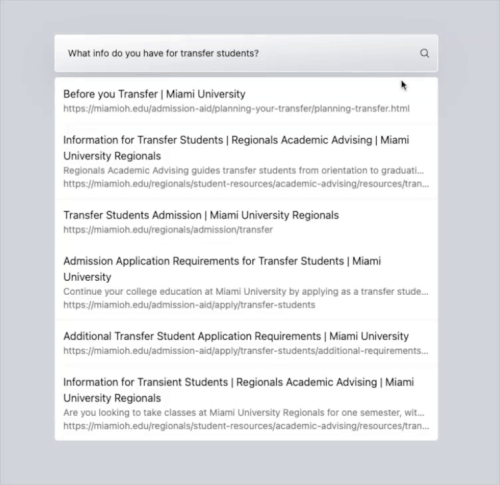AI
Semantic Search & RAG in Higher Ed: The Quiet Revolution in Campus Tech
Published on
Semantic search and RAG (Retrieval-Augmented Generation) are transforming content search (website or other) and will change how prospective and current students get answers.
The rise of AI and accessible vector embedding APIs from Google Gemini and OpenAI has made retrieval-augmented generation and semantic search incredibly approachable for universities. What once required complicated machine learning technology infrastructure is now within reach of any institution.
What is RAG?
RAG (Retrieval-Augmented Generation) is an AI technique that combines the power of large language models with external knowledge retrieval to provide more accurate, up-to-date, and contextually relevant responses.
How it works:
- Retrieval Phase: When you ask a question, the system searches through a knowledge base (documents, websites, databases) to find relevant information
- Augmentation Phase: The retrieved information is added as context to your original question
- Generation Phase: A language model (like GPT or Gemini) uses both your question and the retrieved context to generate a comprehensive, grounded answer
Key benefits:
- Accuracy: Responses are based on specific, verifiable sources rather than just training data
- Currency: Can access the most recent information in your knowledge base
- Transparency: You can see exactly which sources informed the answer
- Customization: Works with your specific organizational content and data
In higher education context:
Instead of a chatbot giving generic answers about “typical university policies,” RAG can pull from your actual student handbook, course catalog, and administrative documents to give precise, institution-specific responses. Think of it as giving an AI assistant access to your filing cabinet so it can find the exact document needed to answer each question accurately.
We’re already seeing companies like CollegeVine building more trained learning systems and Technolutions Slate promising searchable domain content. But this is just the beginning.
How do we know it will be accurate?
This is the technical part of the story. RAG and semantic search use vector embeddings. They’re like coordinates in a vast space that capture the meaning and context of the text. Similar concepts cluster together in this space, while different concepts are farther apart. It’s impossible for humans to visualize, but computers can instantly calculate the distance between any two vectors to determine how similar their meanings are. The “power” comes from the mathematical relationships between vectors in this high-dimensional space.
The results are surprising. Queries like “panda bears” return information about a masters degree in Biology. Queries about a career path, like “I want to be a doctor,” return results about degrees that lead to medical school. This is the power of semantic search.

Behind the scenes, vector embeddings provide an easy mechanism for finding related content. Want to see degree programs most like your BA in Accounting? A cosine vector search will give a list based on meaning, reducing the need for tagging, taxonomy building, or manual content maintenance in your CRM.
At Fathom This, we’ve built a working RAG implementation using website content, storing embeddings in a vector store with a beautifully simple interface. Our system offers:
- Context exclusions for precise results
- Duplicate content identification
- Semantic website search
- AI-augmented results in a chat interface
- Ready-to-embed solution for your site
- RAG and semantic search as a core CMS feature, building an accurate knowledge base as your website changes
The potential applications are endless: instant answers to enrollment questions, faculty research discovery, policy clarification, and student support that never sleeps.
Higher ed institutions sitting on decades of valuable content now have the tools to make it more accessible and actionable. The question isn’t whether RAG will reshape campus information systems—it’s how quickly universities will embrace it.
Ready to see RAG and semantic search in action for your institution? Let’s connect and explore what’s possible.